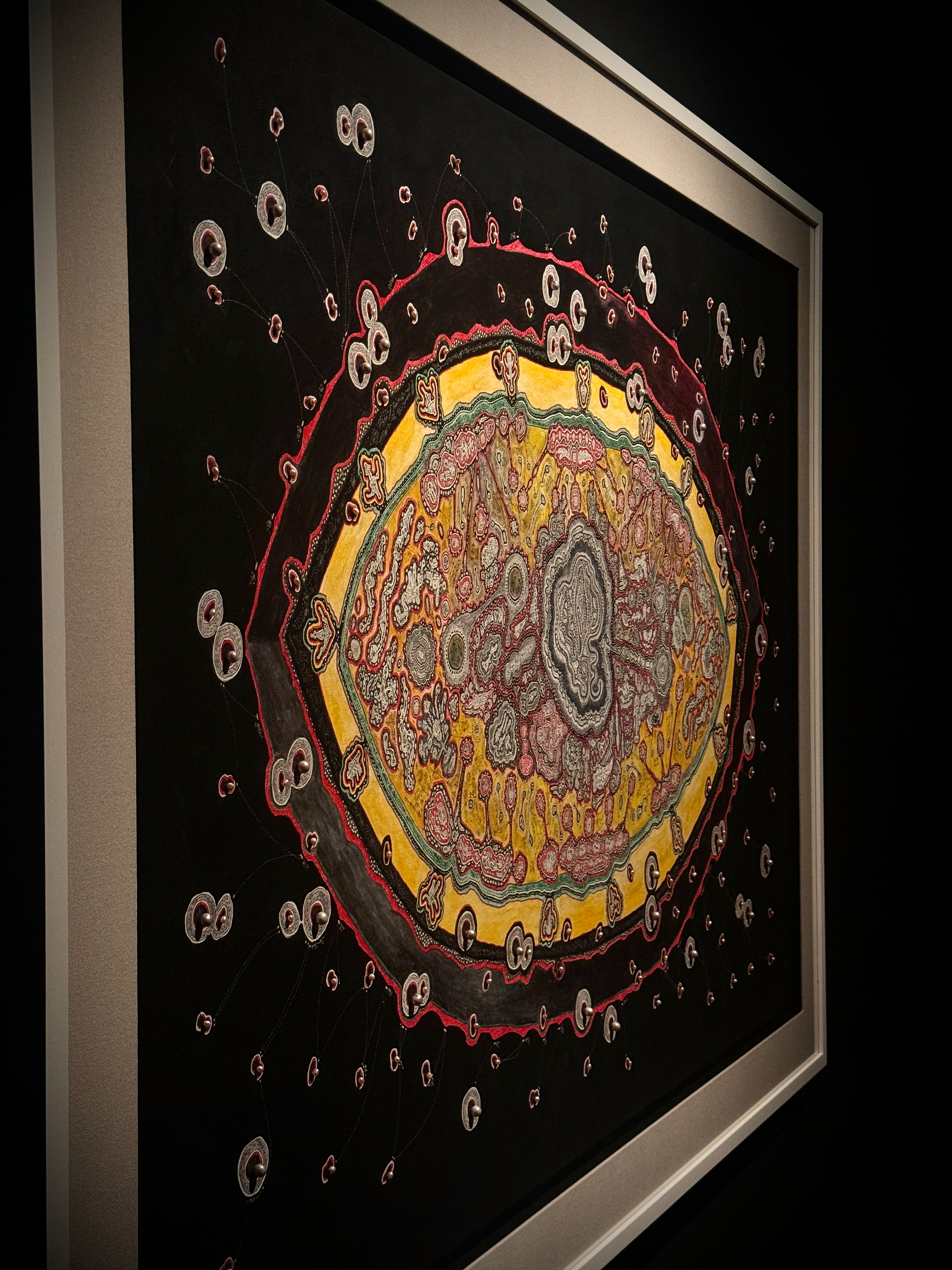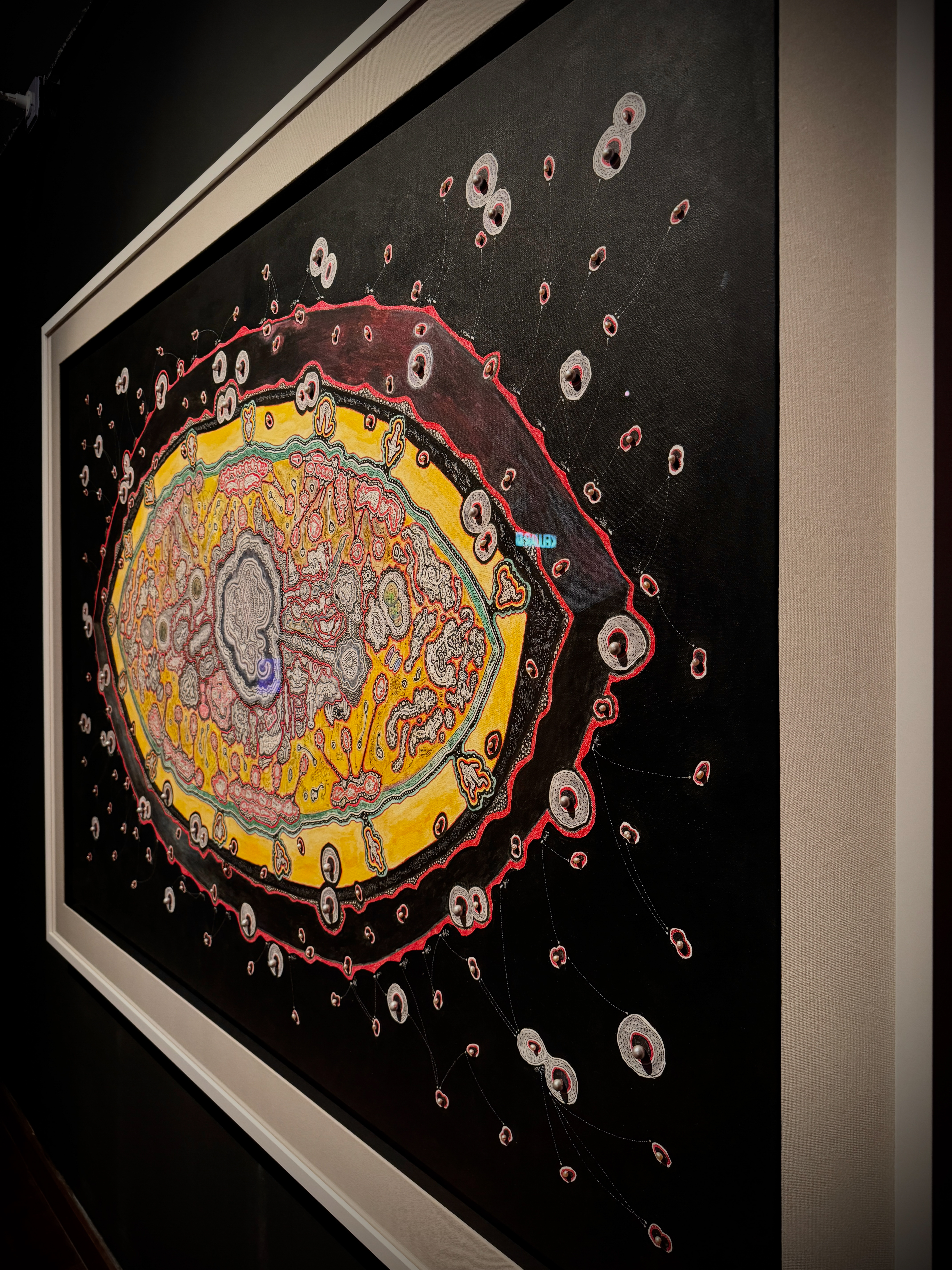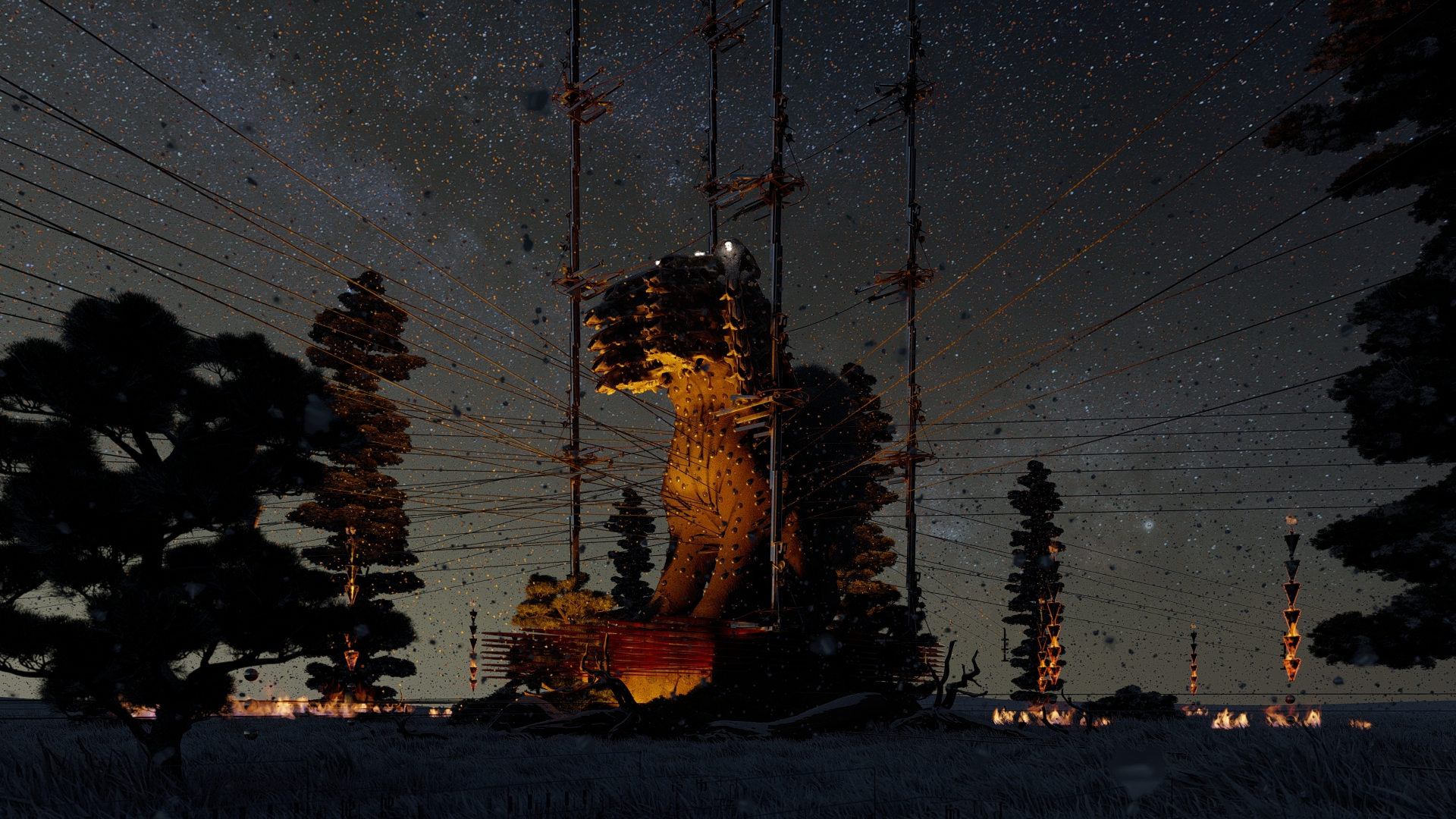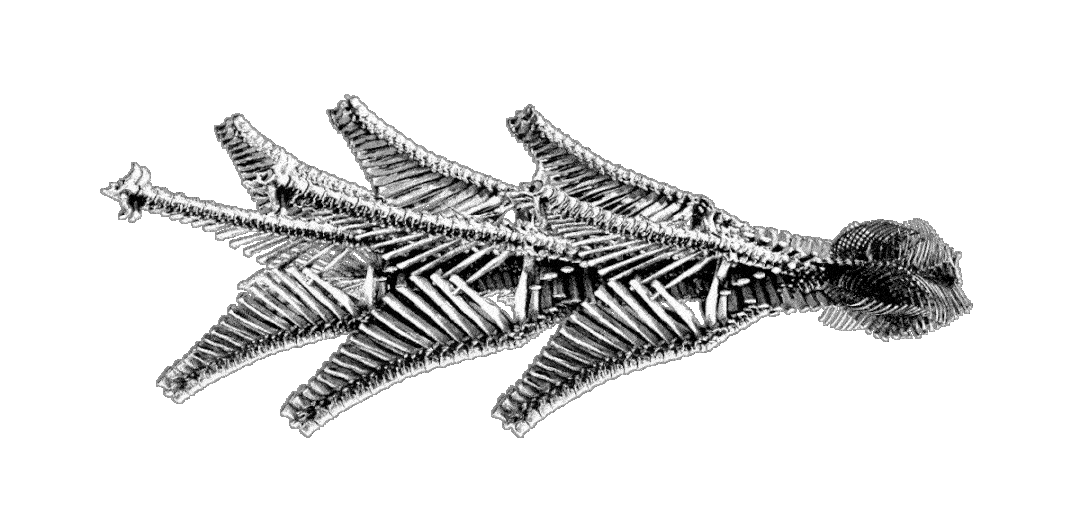
Luópán_羅盤.exe, 2024
Multimedia InstallationCommisioned by the National Art Gallery Malaysia.
For RANTAU IMT-GT.
4 July - 1 December 2024
Art by Chong Yan Chuah
Writing by Ellen Lee ○ Graphic by Ejin Sha
PDF. available here
A cluster of monasteries floats above a remote tropical rainforest. A great multi-headed and -limbed beast soars above the skies like a zeppelin, grounded to earth by a maze of electrical cables. A tower built of steel and human bodies sprouts ever upwards into the sky, a man-machine chimera that is perpetually building itself. And in the background, there is the ceaseless sound of rain falling softly on leaves and a depopulated earth. Could this be what dreams are made of?
Luópán_羅盤.exe brings ancient mythologies to the foreground of the discourse on future intelligence technologies. Luópán (罗盘), which is the name for a traditional Chinese compass used in feng shui, navigation, and Chinese metaphysics, here takes the form of a speculative dream programme created by the fictional tech giant, Somnii. The video that is being screened to global audiences today is a keynote address announcing its launch. Somnii’s spokesperson is Xie Yi Zhang, or XYZ, a floating, ethnically- and sexually-ambiguous avatar who gives new meaning to the idea of diversity in tech.
In her keynote, Xie Yi Zhang breaks down the properties of Luópán.exe, a neural-linked dream programme that promises to revolutionise human consciousness. Within this virtual dreamscape, there are three points on the compass: the realms of San He, San Yuan, and Zhong He, each promising a landscape as visually sublime as it is nostalgically evocative. Throughout the keynote, it remains unclear whether the programme and the realms are meant to be interpreted metaphorically, as a compass for navigating the unconscious, or as an actual dreamscape that people can wilfully explore, like a video game style of lucid dreaming.
Luópán.exe proposes a programme that can sublimate yesterday’s mythologies, today’s dreams, and tomorrow’s technologies all into one. Within this context, the artist is largely absent, a digital shaman who conducts his work behind a screen and visible only through transitory avatars or properties in nature. As in a dream, the work of consciousness is submitted to an obscure power that collapses our categories of reality and leads us into a new understanding of ourselves.

Luópán_羅盤.exe is an immersive, multi-media installation consisting of a video playing on a loop across three mirrored channels and a hand-drawn map depicting the “Luópán constellation”. Malaysian visual artist Chong Yan Chuah has created a fictional universe that crosses cultural boundaries, amalgamating Eastern and Western influences and motifs to create a borderless dream world. Within the context of the exhibition Rantau, the work speculates about future connected societies through the lens of machine technology, while also questioning the consequences that such technological domination may entail.



The Dream Entrepreneurs
by Ellen Lee
—
The year 2042 is bright and dazzling. The years ahead seem even more so, on keynote address day for Luópán_羅盤.exe, a computer programme by Somnii, the world’s largest multinational tech corp, that promises to be the most innovative advancement in brain-computer implant technology to date. People are even saying that it may achieve permanent world peace.
Since the news first leaked 2 years ago about the tech giant’s development of an implantable dream programme, the world’s politicians and media personalities have been locked in speculative debate about the executable’s potential impact on human civilisation. It’s all anyone can talk about. The programme is being welcomed by segments of the establishment as a potential solution to the problem of warfare: the argument goes that dream technology offers a method of influencing the human id to curb destructive impulses that do not and will never serve any benefit to the human race. With the technology to rein in all the nasty impulses that turn men into tyrants and psychopaths, humanity can be directed towards a vision of shared, global prosperity supported by international rights frameworks that are applicable in equal measure to every society all around the world. Luópán can be a compass in more ways than one, a guiding light to help the human soul navigate out of the swampy depths of the unconscious. It offers a means of universal healing and stability after the bloodthirsty excesses of the first half of the century. Instead of endless war over tribalistic differences and the demagoguery of tyrants, Luópán promises ease and balance.
Governments and kingdoms around the world have already entered into talks with Somnii to open beta-testing facilities in their countries in order to hasten the adoption of Luópán across their citizenry. The Department of Singularity Studies at a major eastern university has been studying implantable technologies for years, in search of The One that will actually establish perfect, permanent human-machine singularity on earth, and Luopan is the first programme to show any real signs of promise.
In a dark, blue-carpeted auditorium at the top floor of the national art gallery, a crowd has gathered for the address, comprising representatives across every segment of society, from university students and public intellectuals to media elites and political pundits to high-ranking military personnel and Somnii’s biggest and quietest investors. A minority of the audience are people of no public rank or profession at all who have paid a hefty price to be present today. It’s doubly amazing that they’ve paid the price, since the address is being live-streamed anyway. But in the current age, there’s a premium on live, in-person attendance to momentous events, an experience that’s rapidly becoming rarer as the costs of running them and of travel have skyrocketed to levels unheard of in all of human history. Never has it been so expensive to travel, but never has it been less necessary for anyone to do so. All of them are gathered here today to celebrate the grand launching of Luopan. The air is thick with murmurous anticipation as everyone awaits the address by Somnii leader, Xie Yi Zhang (XYZ).
The applause as the screen comes alive is deafening. There are government and military officials from at least 50 different countries watching gravely from the auditorium’s shadows. In the floors below, masterpieces of art history hang mute in their dark, temperature-controlled galleries. The younger members in the audience are already snapping pictures, whooping and whistling. The overall atmosphere bears more resemblance to a rock concert than any formal address of recent memory. Despite her age, everyone knows that XYZ isn’t really as old as she looks. She’s an eternal icon. She’s the world’s first fully-realised computer CEO of a multinational company.
—Did they age her? She’s looking older than usual, one of the young tech-fluencers mutters to her colleague. She reflexively pats her own cheeks as she says this, admiring the buccal fat removal she got a few months ago. Now her cheeks are razor sharp, like the edge of a knife.
—The highlights are not helping, her colleague whispers back. Both of them had paid for their seats in the audience today. They were among the last few holdouts of the dying profession of physical influencer-ing. Everyone was using AI models now.
The first one whips out Google. XYZ age? she types. The top result: Ageless. XYZ is a computer intelligence. She tries again. XYZ horoscope? The top result: Data is not yet available on horoscopes in Luópán.exe as they are calculated according to the programme’s own complex astrological systems.
This is XYZ, the pioneer of Somnii, the one who has created the landscape we live in today, in which the complex webs of human consciousness have been successfully integrated with the elevated logic systems of computer intelligence. In recent years, she’s been the subject of controversy after her role in certain covert military-technology deals with warring factions in the region of —— had been exposed, and entire meetings have been called in the ICC just to discuss how to nail her, but, well, she’s a computer. Anyway, her contributions in the fields of medicine, data science, computing, and engineering far outshine any dark spots in her history. She practically cured cancer.
Despite that, even during her opening remarks a journalist in one of the back rows is already furiously taking notes for his op-ed on the event for a dissident publication. Who gives a single entity the right to dictate how reality should look like? He transcribes telepathically into the Notes app of his implant. XYZ is confident with all the assurance of a mediocre amalgamated ethnic bot that her version of reality is correct and should be adopted universally, denying truths and realities that deviate from her totalising fiction. Her manner echoes that of Rasputin’s demonic grasp of the Russian royal family at the beginning of the 20th century. The Russian shaman held the entire population of Russia captive and indirectly aided in setting off one of the most destructive wars of human history. XYZ, like a modern-day Rasputin, has cast a spell on the whole world with her deceptive charisma and infuriating agelessness. All attempts thus far to curtail her outsized influence have failed; world leaders are practically marionettes in her hands. The launch of Luópán.exe should be a loud warning sign to all of us that if we don’t break out of the reality she’s manufactured for us, we’re headed towards the undoing of a whole century of progress in human rights and the liberations of oppressed peoples… He goes cold, breaks off his transcribing. For a moment, it almost seems as if the avatar of XYZ is looking right at him.
The sound of rain. A majestic cluster of monasteries floats above a tropical jungle. This is one of the points on the compass. It’s modelled upon ancient Buddhist monasteries, citadels of human greatness erected far from the dirt and pettiness of the cities, where monks and scribes lived in perfect isolation, a literal elevation of their world to a higher plane where they performed their religious duties with clockwork adherence and lost themselves in contemplation of the higher intelligences that run the world.
A sense of sadness pervades the auditorium, though no one is consciously aware of it. Everyone thinks the sadness is their own. As the big moon rises in the horizon of San He, one of the points on the compass of Luópán, the audience collectively wishes for annihilation. The whole roomful of them are like dogs who have been abandoned by their owners. Some memories struggle to surface in their consciousness, only to drown at the first cold touch of air above the dark waters. I’ve been here before. I’ve heard of this before. I think this was where I was born, or maybe where the first incarnation of myself originated. The journalist’s heart is beating so fast, he can’t find the words to describe what tyranny it is, to impose such a reality on people, he’s still transcribing for his piece but his consciousness is pulled into the magnetic field of Luópán’s ageless universe. Somnii wants to bring us back to 1914 — no, to the Middle Ages — no, to the first Qin dynasty — no, to the caves in hills — no, back into the cosmic soup of nothingness — it wants to deny all our identities and impose its own Sino-centric worldview on all our histories — the erasure of oneiric cultures — the annihilation of the individual antipathies that make us who we are —
Cut to break. Now for a message from our sponsors.
When the dream resumes, the audience finds themselves plunged into a futuristic lotus pond in the grounds of a temple complex deep in a misty forest, where megaflora have returned from extinction and flowers grow up to the sky, their slender stems supported by metal braces. In the centre of the temple grounds sits a beast with a golden skeleton for a body and horned mask for a face, serenely contemplating the slowly moving world that revolves around it.
On one of the walls of the auditorium hangs a hand-drawn map of Luópán. One of the military personnel shifts in his seat to study it. The traditionalness of its medium lends it a sort of rustic and anachronistic touch that’s slightly jarring given the circumstances, but which affords a sentiment of old-world dignity and a tug of nostalgic familiarity to the proceedings. The map is a red amoebic splotch with complex arrows, dots, and lines describing the landscape. The military man tries his best to make sense of this protozoan diagram, but it’s unlike any map he’s ever seen, even those from the Old World, and his neural implant loads for several long seconds before it manages to produce a meagre analysis of it for him. The cluster at the centre of the map must be the baby Odomzig, a zone of digestion reminiscent of a diagram of the human stomach and intestines. The multifarious symbols are nodes of connectivity and signals between computer intelligences. It’s amazing to see the unconscious of man and machine mapped out like that.
XYZ ends her address with a quote from Chat GPT3.5. AI whispers of post-human dawn, where souls and circuits dance as one, forging futures yet unseen.
During the final commercial break, everyone in the audience is stunned. Nobody really knows what to think. As XYZ breaks into song, one of the students from the Department of Singularity Studies at the major university pretends to yawn and stretch his arms, a posture of faux nonchalance that masks the conflicting feelings within himself as he tries not to pay too much attention to the song that XYZ is singing.
—So you gonna cop that Luópán when it drops or nah? he asks the classmate sat next to him, faking a look of bleariness.
—I’m lowkey feeling it, dude. I been having these crazy dreams lately. This could help with that. I been falling asleep at five, six, seven in the AM. Waking up and not knowing if it’s night or day.
—Oh forreal. What kind of dreams?
—I literally don’t even know man. Like I wish there was an airplane mode for my brain sometimes so I could sleep without all this like terrible vividness. I have dreams of like abandoned houses, buildings, and I don’t even know where they are. Sometimes it’s like some place that looks like it’s Soviet Russia or some shit. Like a war zone where the war ended years ago and all the people are gone. I just see abandoned buildings from a distance and then suddenly I’m in them, pressing buttons in a dim elevator, like those Old World types with only a single bulb set in the ceiling. Then I’m in some corridor and there’s trash all over the place and it looks like nobody’s been there in years, but I know I’m headed to meet someone. Other times I dream of like abandoned hotels or chalets in places that look like Switzerland or some shit, like mountains. I’m in the mountains in some hotel in wintertime and I know my parents are in another room in the same hotel, only I never see them, and there’s some emergency like I need to catch a train straightaway to get somewhere only I can’t find the receptionist to book me a ride to the train station. But like I’ve never been on a train or visited no mountains dude.
—I see. Well your dreams already sound like these Luópán zones so I’m not sure how that’s gonna help. Like.
—Yeah but it’s different. The places in my dreams are buildings, old abandoned buildings that I've never seen before and look nothing like what buildings do now. The vibe of Luópán is almost like my dreams but it feels anchored to something, like every zone is connected to the others and like there’s an invisible tour guide bringing me around and it’s empty but not abandoned. Like the whole half hour felt like I was just taking a light nap. Not like the anxiety I always feel when I’m dreaming. This shit is like airplane mode dude.
—Give me your review of it once you’ve tried it then. I think I’mma sit this one out till I hear a bit more of user feedback at least.
The truth was that the student had been having similar dreams. This was his first time hearing that someone else had the same dreams too and it sort of pricked his ego to realise that his dreams weren’t particular to him, and his own individual make-up, but were probably symptomatic of some wider societal malaise.
XYZ’s final song came to an end, but the lights didn’t go up in the auditorium. The audience started shuffling out. As they did so, an algorithm tabulated their aggregate emotions through the protein data recorded on their implants and synced to the cloud. The general feelings as the audience filed out the hall were: exhausted, melancholic, contemplative, wistful.
Constellation Luopan
Mixed media on linen
(acrylic, polychromos, ink, and pearls)
86 1/4 x 61 1/4 inch




World of Luópán
Single-channel VFX video
22 mins 22 secs, 16:9, 1920 × 1080p
(Exhibited as three-channel mirrored video, looped)















